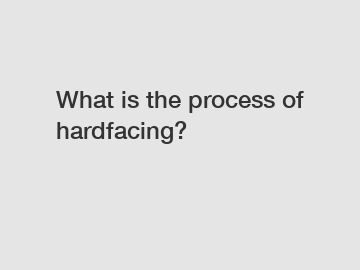What is the process of hardfacing?
What is the process of hardfacing? A comprehensive guide.
Have you ever wondered how to enhance the durability and longevity of your tools, equipment, or even your favorite possession? Hardfacing might be the solution you're seeking. In this article, we will delve into the intricate process of hardfacing, exploring its benefits, application methods, and various materials used. So, let's dive right in!
1. Understanding hardfacing:

Hardfacing is a technique that involves depositing a layer of wear-resistant material onto a surface, typically made of metal. The purpose of the process is to prolong the lifespan of the base metal by enhancing its resistance against severe abrasion, impact, erosion, heat, or any other form of wear and tear. With hardfacing, you can transform ordinary steel into a robust, long-lasting component capable of withstanding harsh operating conditions.
2. The importance of hardfacing:
When it comes to maximizing the performance of critical components, hardfacing plays a vital role. By significantly increasing the wear resistance and hardness of the base material, hardfacing can prevent premature failure, reduce downtime, and ultimately save costs. This process is widely used across industries such as mining, construction, agriculture, oil and gas, and manufacturing.
3. Different methods of hardfacing:
There are several methods available for hardfacing, including manual metal arc welding (MMA), submerged arc welding (SAW), gas metal arc welding (GMAW), and oxy-fuel welding (OFW). Each method offers distinct advantages and is chosen based on the application requirements and availability of resources. For instance, MMA is cost-effective and suitable for on-site repairs, while SAW provides high deposition rates and excellent weld quality in industrial settings.
4. A closer look at hardfacing materials:
Various materials can be used for hardfacing, depending on the specific wear conditions and desired properties. Common hardfacing alloys include chromium carbide, tungsten carbide, nickel-based alloys, cobalt-based alloys, and iron-based alloys. These materials exhibit exceptional hardness, toughness, and resistance to wear, thereby extending the life of the component.
5. Application areas for hardfacing:
Hardfacing finds extensive application in diverse industries. Mining equipment, such as buckets, cutting edges, and drill bits, are often hardfaced to withstand the abrasive nature of ores and rocks. Similarly, agricultural machinery like plows, harrows, and tillage tools benefit from hardfacing, as they encounter harsh soil conditions. Moreover, components subjected to extreme heat and corrosion, such as valves, pumps, and refinery equipment, can be protected through hardfacing.
6. Factors influencing hardfacing success:
While hardfacing offers numerous advantages, achieving successful results depends on various factors. Proper selection of the hardfacing material, identifying the right welding method, and maintaining the correct deposition rate and coverage are crucial. Preparing the base metal, such as cleaning and removal of any contaminants, is equally important to ensure proper adhesion. Additionally, skilled operators with knowledge of welding parameters and techniques are essential for effective hardfacing.
7. Post-hardfacing considerations:
Once hardfacing is complete, it is essential to evaluate the results and undertake any required finishing processes. This may involve grinding, machining, or polishing to achieve the desired dimensions and surface quality. Proper inspection and quality control ensure the hardfaced component meets the specified requirements and can perform optimally in its intended environment.
In conclusion, hardfacing is a process that significantly enhances the wear resistance and durability of components exposed to extreme conditions. By choosing the right hardfacing method and material, industries can extend the life of their valuable equipment, reduce maintenance costs, and improve overall operational efficiency. So, the next time you encounter severe wear challenges, consider hardfacing as a reliable solution to protect and enhance the longevity of your critical assets.
Contact us to discuss your requirements of cladding wear plates factory, hardfacing welding wire supplier, Wear Plate Manufacturer. Our experienced sales team can help you identify the options that best suit your needs.
150
0
0


Comments
All Comments (0)